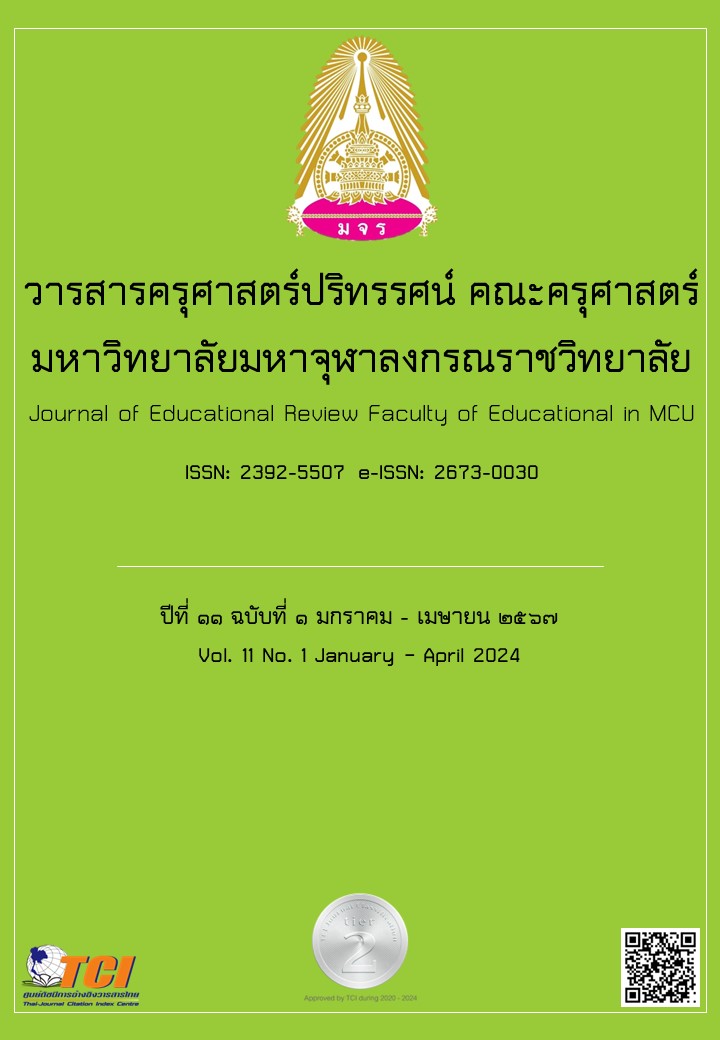THE DEVELOPMENT OF INTERACTIVE ELECTRONIC BOOK BY USING FLIPPED LEARNING CONCEPT TO ENHANCE CHINESE LISTENING AND SPEAKING SKILLS FOR GRADE 5 STUDENTS OF RATCHAWAT WITTHAYA SCHOOL
Main Article Content
Abstract
This research article is about the development of listening and speaking abilities in the Chinese language using a flipped learning approach, which emphasizes the importance of learners. The objectives of this research are as follows: 1) To develop electronic books (e-books) along with the flipped learning concept to enhance the quality and effectiveness of listening and speaking abilities according to the 80/80 criteria. 2) To study the listening and speaking abilities in the Chinese language after using e-books. 3) To examine the learning performance before and after using e-books. 4) To assess learner satisfaction with e-books. The target group for this research consisted of 22 fifth-grade students from Ratchawat Witthaya School. In the first semester of the 2023 academic year, the research followed an experimental approach, using the following research tools: 1) Interactive e-books 2) Quality assessment forms 3) Satisfaction questionnaires 4) Statistical tools for data analysis, including mean and standard deviation The research findings revealed: 1) The e-books, as evaluated by experts, were of very high quality, with an average score of 4.44 for content and 4.91 for media quality. They were also effective, scoring 80.27/84.54, meeting the predefined criteria of 80/80. 2) Students' listening and speaking abilities in the Chinese language improved significantly after using the e-books. 3) Student learning performance after using e-books was statistically significantly higher compared to their scores before using them (at the 0.05 significance level). 4) Students expressed the highest level of satisfaction with the e-books, with an average score of 4.91.
Article Details

This work is licensed under a Creative Commons Attribution-NonCommercial-NoDerivatives 4.0 International License.
ทัศนะและความคิดเห็นที่ปรากฏในบทความในวารสารฉบับนี้ถือเป็นความรับผิดชอบของผู้เขียนบทความนั้นเพียงผู้เดียว และไม่ถือเป็นทัศนะและความรับผิดชอบของกองบรรณาธิการ
กองบรรณาธิการขอสงวนสิทธิ์ในการคัดเลือกบทความลงตีพิมพ์และจะแจ้งให้เจ้าของบทความทราบหลังจากผู้ประเมินบทความตรวจอ่านบทความแล้ว
ต้นฉบับที่ได้รับการตีพิมพ์ในวารสารครุศาสตร์ปริทรรศน์ คณะครุศาสตร์ มหาวิทยาลัยมหาจุฬาลงกรณราชวิทยาลัย ถือเป็นกรรมสิทธิ์ของคณะครุศาสตร์ มหาวิทยาลัยมหาจุฬาลงกรณราชวิทยาลัย ห้ามนำข้อความทั้งหมดหรือบางส่วนไปพิมพ์ซ้ำ เว้นเสียแต่ว่าจะได้รับอนุญาตจากมหาวิทยาลัยฯ เป็นลายลักษณ์อักษร
References
กระทรวงศึกษาธิการ. (2553). แนวปฏิบัติการวัดและประเมินผลการเรียนรู้ตามหลักสูตรแกนกลางการศึกษาขั้นพื้นฐานพุทธศักราช 2551. พิมพ์ครั้งที่ 2. กรุงเทพมหานคร: โรงพิมพ์ชุมนุมสหกรณ์การเกษตรแห่งประเทศไทย
จริยา แก้วศรีนวม. (2557). การพัฒนาแผนการจัดกิจกรรมการเรียนการสอนภาษาไทยตามรูปแบบการเรียนการสอนแบบซินเนคติคส์เพื่อพัฒนาความสามารถในการเขียนเชิงสร้างสรรค์ของนักเรียนชั้นมัธยมศึกษาปีที่ 3. วิทยานิพนธ์ครุศาสตรมหาบัณฑิต. มหาวิทยาลัยราชภัฏสกลนคร.
ทิศนา แขมมณี. (2547). ศาสตร์การสอน : องค์ความรู้เพื่อการจัดกระบวนการเรียนรู้ที่มีประสิทธิภาพ. พิมพ์ครั้งที่ 3. กรุงเทพมหานคร: สำนักพิมพ์แห่งจุฬาลงกรณ์มหาวิทยาลัย.
นิภาพร บุญกุศล. (2554). การวิจัยเชิงปฏิบัติการเพื่อพัฒนาทักษะการฟังการพูดและการเรียนรู้คำศัพท์ภาษาอังกฤษของนักเรียนชั้นประถมศึกษาปีที่ 5 โดยใช้ชุดกิจกรรมการเล่านิทานและบทบาทสมมติ. วิทยานิพนธ์ครุศาสตรมหาบัณฑิต. มหาวิทยาลัยราชภัฎสกลนคร.
ประภาพร นุชอำพันธ์. (2554). การพัฒนาชุดการสอนภาษาอังกฤษ เรื่อง อาหารและสุขภาพ สำหรับนักเรียนชั้นประถมศึกษาปีที่ 5. การศึกษาค้นคว้าอิสระศึกษาศาสตร์มหาบัณฑิต. มหาวิทยาลัยนเรศวร.
โรงเรียนราชวัตรวิทยา. (2564). การวัดและประเมินผลความสามารถในการฟังและพูดภาษาจีน. กรุงเทพมหานคร: โรงเรียนราชวัตรวิทยา.
สำนักงานคณะกรรมการการศึกษาขั้นพื้นฐาน. (2558). คู่มือการจัดการเรียนการสอนภาษาอังกฤษแนวใหม่ตามกรอบมาตรฐานความสามารถทางภาษาอังกฤษที่เป็นสากล. กรุงเทพมหานคร: โรงพิมพ์องค์การสงเคราะห์ทหารผ่านศึก.
อารีย์ พันธ์มณี. (2546). จิตวิทยาสร้างสรรค์การเรียนการสอน. กรุงเทพมหานคร: ใยไหมเอดดูเค.
Jonathan, B. & Aaron, S. (2013). Flip your student’s learning. Educational Leadership. 70(6). 16-20.
Jonathan, B. & Aaron, S. (2012). Flip Your Classroom Reach Every Student in Every Class Every Day. Intl Society for Technology in educ.
Ratsameeporm, W. (1999). Design and development of teaching. Bangkok: Srinakharinwirot University Press.
Torrance. (1963). Education and the Creative Potential. Minneapolis: The Lund Press.

